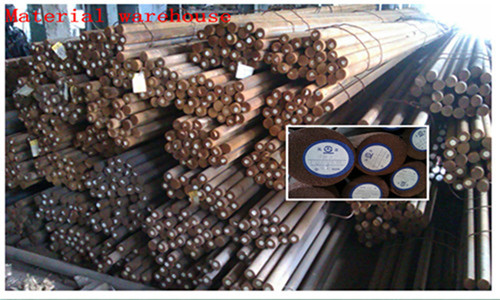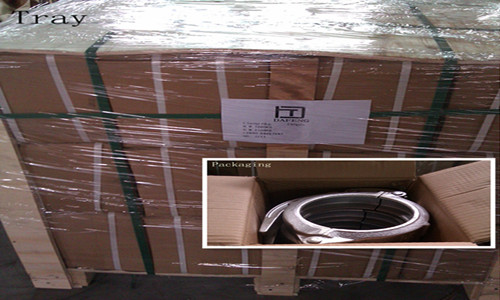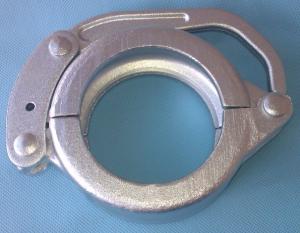Concrete Pump Clamp Coupling DN100 Forged
- Loading Port:
- China main port
- Payment Terms:
- TT OR LC
- Min Order Qty:
- 50 PCS
- Supply Capability:
- 10000 PCS/month
OKorder Service Pledge
OKorder Financial Service
You Might Also Like
Product Description:
A coupling is a device used to connect two delivery pieps together at their ends for the purpose of transmitting, and prevent the concrete from leaking. Couplings do not normally allow disconnection of shafts during operation.
Main Product Features:
1. Use high quality steel. After high-temperature 1200 forging,it’s shaped.
2.High temperature forging.
3.convenient to use, easy operation,and high safety.
4.good sealing,wear-resising,longer service life.
5.do not restrict the steering tubes, pipes during the working process can be 360 degrees rotation.
6.used in concrete pump truck,concrete pump and pipeline connection seal in construction
work equipment.
Product Specifications:
1.Forged
2.2--8 inch
3.Galvanizing/Baking varnish
4.More durable,light,beautiful
Production steps:









Concrete pump clamp Catalogue


FAQ
1.How do you regarding your product quality?
As our principle is more safety to save more. In China, there are lots of manufactures of this line, but we are the first one that use the forging technic in producing, firmly meet the PM standard.
2.Can I get some samples?
Of course you can. Small sample for free, but you pay the express. For some products are not small, like concrete pump pipe, it’s very difficult to deliver one pipe of 3000mm. If it’s possible, we’d like that you can come here to visit our factory. Welcome!
3. I want to make our logo on the products, is that ok?
Yes, it’s totally ok. OME is available from us.What you should do is send your logo, brand name, or picture to us. And let other things leave on us.
- Q: What is the function of a concrete pump hopper grate lever?
- The concrete pump hopper grate lever serves the purpose of regulating the opening and closing of the hopper grate on a concrete pump. The hopper grate, which is a metal grid covering the chamber where the concrete is loaded before being pumped, is controlled by this lever. This lever grants the operator the ability to effortlessly adjust the position of the grate. It can be opened to allow the concrete to flow into the hopper or closed to prevent any debris or foreign objects from entering the pump system. The control provided by the lever is essential for ensuring the smooth and efficient operation of the concrete pump. Any obstructions or contaminants in the hopper have the potential to cause damage to the pump or compromise the quality of the concrete being pumped. By utilizing the hopper grate lever, the operator can maintain a constant flow of concrete into the pump and ensure that only clean and properly mixed concrete is used. Moreover, the lever serves as a safety precaution, allowing the operator to swiftly close the grate in the event of an emergency or malfunction. In conclusion, the concrete pump hopper grate lever plays a critical role in the effective functioning and upkeep of a concrete pump system.
- Q: What is the purpose of a concrete pump hydraulic oil filter?
- The primary objective of a concrete pump's hydraulic oil filter is to eliminate impurities and contaminants from the hydraulic oil that is utilized in the pump system. The hydraulic oil plays a critical role in the smooth operation and durability of the pump by offering the necessary lubrication and cooling for the hydraulic components. Nevertheless, as time passes, the oil can accumulate dirt, debris, and other particles that can cause harm and decrease the pump's efficiency. The hydraulic oil filter is purposefully designed to capture and eliminate these contaminants, ensuring that only clean and filtered oil circulates throughout the entire system. By doing so, it effectively preserves the performance and dependability of the concrete pump, averting potential breakdowns, and prolonging the lifespan of the hydraulic components.
- Q: How often should the concrete pump wear plate be replaced?
- The frequency of replacing the concrete pump wear plate depends on several factors such as the type of concrete being pumped, the volume of concrete being pumped, and the operating conditions of the pump. Generally, wear plates are designed to withstand a certain amount of wear and tear before requiring replacement. In most cases, it is recommended to inspect the wear plate regularly to check for signs of excessive wear. This can include visible cracks, erosion, or a significant decrease in thickness. Regular visual inspections can help determine when it is time to replace the wear plate. Additionally, monitoring the pump's performance and efficiency can also provide insights into the wear and tear on the wear plate. If there is noticeable decrease in the pump's output or an increase in the required pumping pressure, it may indicate that the wear plate needs to be replaced. However, it is important to consult the manufacturer's guidelines and recommendations for your specific concrete pump model. They often provide recommendations on the expected lifespan of the wear plate and the intervals at which it should be replaced. Following these guidelines can help ensure optimal performance and longevity of your concrete pump.
- Q: Can concrete pump spare parts be retrofitted to older pump models?
- Yes, concrete pump spare parts can be retrofitted to older pump models. However, it is essential to ensure compatibility and proper installation to guarantee optimal performance and safety. Professional advice and support should be sought to ensure correct retrofitting of spare parts to older pump models.
- Q: What are the different types of concrete pump clamps?
- There are several different types of concrete pump clamps available, each designed to serve a specific purpose and fit different pump sizes. Some of the common types include: 1. Snap clamps: These clamps are easy to install and remove as they utilize a snap mechanism. They are typically used for securing smaller diameter hoses and pipes. 2. Bolt clamps: Bolt clamps are more sturdy and provide a stronger grip. They consist of a metal band with bolts that can be tightened to secure the hose or pipe in place. These clamps are commonly used for larger diameter hoses and pipes. 3. Wedge clamps: Wedge clamps use a wedge device to hold the hose or pipe firmly in place. These clamps are often used in high-pressure applications or when working with heavy-duty pumps. 4. Quick-release clamps: Quick-release clamps are designed for easy and fast installation and removal. They feature a lever or latch that allows for quick release and adjustment. These clamps are commonly used in situations where frequent hose or pipe changes are required. 5. Flanged clamps: Flanged clamps are specifically designed to secure pipes with flanges. They provide a tight and secure connection between the pump and the pipe, preventing leaks or disconnections. It's important to choose the right type of concrete pump clamp based on the specific requirements of your project, including the pump size, hose or pipe diameter, and the expected pressure. Consulting with a professional or supplier can help ensure you select the appropriate clamp for your needs.
- Q: What is the purpose of a concrete pump accumulator?
- The purpose of a concrete pump accumulator is to store energy and provide a steady and consistent flow of concrete during the pumping process. It acts as a buffer between the pump and the delivery line, ensuring that the concrete is delivered smoothly and without interruption. The accumulator works by compressing air or nitrogen, which is then used to push the concrete through the pipeline when the pump is not actively pumping. This helps to maintain pressure and prevent any blockages or irregularities in the concrete flow. Additionally, the accumulator can help to reduce wear and tear on the pump by absorbing pressure fluctuations and providing a more controlled and consistent flow of concrete. Overall, the purpose of a concrete pump accumulator is to enhance the efficiency, reliability, and performance of the pumping process.
- Q: Are there any specific troubleshooting steps for identifying issues with concrete pump spare parts?
- Concrete pump spare parts can be identified for issues by following specific troubleshooting steps. These steps include conducting a thorough visual inspection of the spare parts to look for signs of wear, damage, or misalignment. Cracks, breaks, or any visible signs of damage should be checked for. The functionality of the spare parts can be tested by operating the concrete pump and paying attention to abnormal noises, vibrations, or irregular movements. A pressure test can be performed by connecting a pressure gauge to the pump and checking if it reaches the desired pressure levels. Any abnormal pressure fluctuations can indicate issues. A flow test can be conducted to evaluate the flow rate of the concrete through the pump and check for any blockages or irregular flow patterns. The spare parts should be inspected for leaks or fluid seepage, which can indicate faulty seals, gaskets, or fittings. Technical manuals provided by the manufacturer can be consulted for troubleshooting guidelines specific to the concrete pump spare parts. If unable to identify the issue, it is advisable to seek expert advice from a qualified technician or the manufacturer's technical support team. By following these troubleshooting steps, it becomes easier to promptly identify and address any issues with concrete pump spare parts.
- Q: Can concrete pump spare parts be ordered in bulk quantities for future use?
- Yes, concrete pump spare parts can definitely be ordered in bulk quantities for future use. Many suppliers and manufacturers offer bulk ordering options to cater to the needs of contractors and construction companies. Ordering in bulk can provide several advantages such as cost savings, convenience, and ensuring a consistent supply of spare parts for maintenance and repairs. It is always recommended to have spare parts readily available to minimize downtime and maximize the efficiency and performance of concrete pumps.
- Q: What are the types of concrete pumps?
- According to the power type is divided into electric concrete pump and diesel power concrete pump
- Q: Are there any specific safety considerations when using concrete pump spare parts?
- Yes, there are several specific safety considerations when using concrete pump spare parts. Firstly, it is crucial to ensure that the spare parts being used are compatible with the particular concrete pump model. Using incompatible spare parts can lead to malfunctioning, which can cause accidents or injuries. Secondly, proper training and knowledge of the concrete pump and its spare parts are essential to ensure safe operation. Operators should be trained on how to install, maintain, and replace the spare parts correctly. They should also be aware of any specific safety precautions or guidelines provided by the manufacturer. Additionally, it is important to regularly inspect the spare parts for any signs of wear, damage, or deterioration. Any damaged or worn-out parts should be replaced immediately to prevent accidents or equipment failure. Furthermore, using personal protective equipment (PPE) is crucial when working with concrete pump spare parts. This may include safety goggles, gloves, hard hats, and steel-toed boots, among others. PPE helps protect against potential hazards such as flying debris, falls, or contact with hazardous substances. Lastly, it is advisable to follow all relevant safety regulations and guidelines provided by local authorities and industry standards. These regulations may include specific requirements for the installation, operation, and maintenance of concrete pump spare parts. By adhering to these safety considerations, operators can minimize the risk of accidents, injuries, and equipment failure when using concrete pump spare parts.
Send your message to us
Concrete Pump Clamp Coupling DN100 Forged
- Loading Port:
- China main port
- Payment Terms:
- TT OR LC
- Min Order Qty:
- 50 PCS
- Supply Capability:
- 10000 PCS/month
OKorder Service Pledge
OKorder Financial Service
Similar products
Hot products
Hot Searches
Related keywords






























